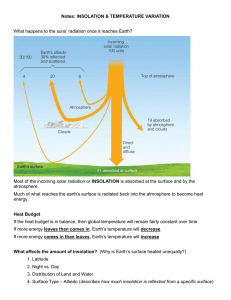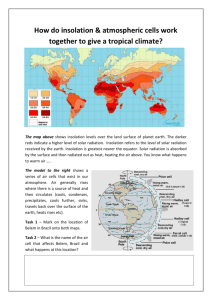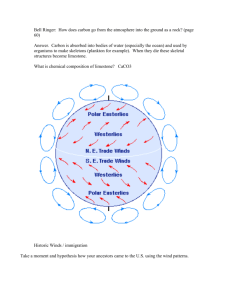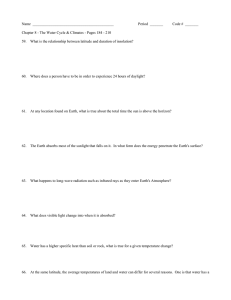EFFECTS OF THE SEASONAL SUNLIGHT VARIATION ON PREDICTIONS OF THE SOLAR-AEOLIC POTENTIAL FOR POWER GENERATION
advertisement
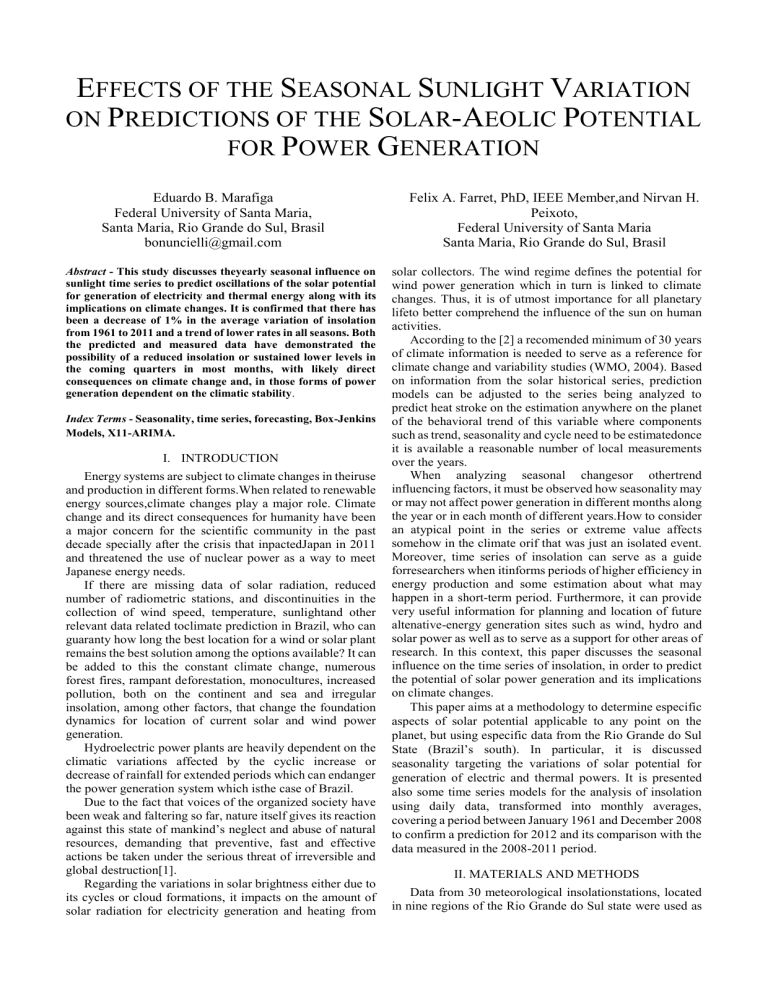
EFFECTS OF THE SEASONAL SUNLIGHT VARIATION ON PREDICTIONS OF THE SOLAR-AEOLIC POTENTIAL FOR POWER GENERATION Eduardo B. Marafiga Federal University of Santa Maria, Santa Maria, Rio Grande do Sul, Brasil bonuncielli@gmail.com Abstract - This study discusses theyearly seasonal influence on sunlight time series to predict oscillations of the solar potential for generation of electricity and thermal energy along with its implications on climate changes. It is confirmed that there has been a decrease of 1% in the average variation of insolation from 1961 to 2011 and a trend of lower rates in all seasons. Both the predicted and measured data have demonstrated the possibility of a reduced insolation or sustained lower levels in the coming quarters in most months, with likely direct consequences on climate change and, in those forms of power generation dependent on the climatic stability. Index Terms - Seasonality, time series, forecasting, Box-Jenkins Models, X11-ARIMA. I. INTRODUCTION Energy systems are subject to climate changes in theiruse and production in different forms.When related to renewable energy sources,climate changes play a major role. Climate change and its direct consequences for humanity have been a major concern for the scientific community in the past decade specially after the crisis that inpactedJapan in 2011 and threatened the use of nuclear power as a way to meet Japanese energy needs. If there are missing data of solar radiation, reduced number of radiometric stations, and discontinuities in the collection of wind speed, temperature, sunlightand other relevant data related toclimate prediction in Brazil, who can guaranty how long the best location for a wind or solar plant remains the best solution among the options available? It can be added to this the constant climate change, numerous forest fires, rampant deforestation, monocultures, increased pollution, both on the continent and sea and irregular insolation, among other factors, that change the foundation dynamics for location of current solar and wind power generation. Hydroelectric power plants are heavily dependent on the climatic variations affected by the cyclic increase or decrease of rainfall for extended periods which can endanger the power generation system which isthe case of Brazil. Due to the fact that voices of the organized society have been weak and faltering so far, nature itself gives its reaction against this state of mankind’s neglect and abuse of natural resources, demanding that preventive, fast and effective actions be taken under the serious threat of irreversible and global destruction[1]. Regarding the variations in solar brightness either due to its cycles or cloud formations, it impacts on the amount of solar radiation for electricity generation and heating from Felix A. Farret, PhD, IEEE Member,and Nirvan H. Peixoto, Federal University of Santa Maria Santa Maria, Rio Grande do Sul, Brasil solar collectors. The wind regime defines the potential for wind power generation which in turn is linked to climate changes. Thus, it is of utmost importance for all planetary lifeto better comprehend the influence of the sun on human activities. According to the [2] a recomended minimum of 30 years of climate information is needed to serve as a reference for climate change and variability studies (WMO, 2004). Based on information from the solar historical series, prediction models can be adjusted to the series being analyzed to predict heat stroke on the estimation anywhere on the planet of the behavioral trend of this variable where components such as trend, seasonality and cycle need to be estimatedonce it is available a reasonable number of local measurements over the years. When analyzing seasonal changesor othertrend influencing factors, it must be observed how seasonality may or may not affect power generation in different months along the year or in each month of different years.How to consider an atypical point in the series or extreme value affects somehow in the climate orif that was just an isolated event. Moreover, time series of insolation can serve as a guide forresearchers when itinforms periods of higher efficiency in energy production and some estimation about what may happen in a short-term period. Furthermore, it can provide very useful information for planning and location of future altenative-energy generation sites such as wind, hydro and solar power as well as to serve as a support for other areas of research. In this context, this paper discusses the seasonal influence on the time series of insolation, in order to predict the potential of solar power generation and its implications on climate changes. This paper aims at a methodology to determine especific aspects of solar potential applicable to any point on the planet, but using especific data from the Rio Grande do Sul State (Brazil’s south). In particular, it is discussed seasonality targeting the variations of solar potential for generation of electric and thermal powers. It is presented also some time series models for the analysis of insolation using daily data, transformed into monthly averages, covering a period between January 1961 and December 2008 to confirm a prediction for 2012 and its comparison with the data measured in the 2008-2011 period. II. MATERIALS AND METHODS Data from 30 meteorological insolationstations, located in nine regions of the Rio Grande do Sul state were used as platykurtic (kurtosis value <3) relative to the normal distribution curve, Figure 1. Fig. 1. Histogram of the insolation series (insolation x frequency distribution). The Jarque-Bera Normality test was carried out with the objective of offering credibility to the statistic tests, due to to the fact that they are based on the normal distribution of the residual term. The tested hypothesis were: H0: Assymetry = 0 and kurtosis = 3, thus, the serie is considered normal; H1: Assymetry ≠ 0 and kurtosis ≠ 3, thus, the serie is considered not normal. It can be observed that the variable does not follow a normal distribution, given that the calculated value of 5.39 is lower than the standard number 5.99, this can be observed in Figure 1. According to Figure 2, this insolation series does not show a clear trend, but only major variations over the years. As the series presents a wide variation in their stability, a different series is proposed to perform the studies on series seasonality. The graph of the autocorrelation function for the first difference (Figure 3) suggests some seasonal effects. The study of seasonality with time series according to [7] has two objectives: the analysis of the seasonality itself and removal of seasonality from the series for later study about other aspects. This series was subjected to several Friedman and Kruskal Wallis tests for verification of stable seasonalities. The results of these tests are shown in Table 1 where it can be seen that the series has a stable seasonally in the variation of sunlight. 11 10 9 8 Insolação (h) described in Table 1. The Rio Grande do Sul (RS) state is located in the extreme south of Brazil, between latitudes from 27° to 34°S and longitude from 50° to 57°W. These datawere provided by the following organizations: Agrometeorology Labof theState Foundation of Agropecurary Research (FEPAGRO-RS), the National Institute of Meteorology, INMET, and the Weather artnership Stationfrom Pelotas/EMBRAPA, UFPel/INMET. For an improved data processing, the daily information were transformed into monthly averages totaling 48 years of information. When working with enviromental data it is not rare to find incomplete or poorly historical data series, especially when it comes to very large time periods, as is the case in this study. According to [3] incomplete series should be treated as time series using the Box-Jenkins models which is based on identifying models from the time series behavior constituting a fast and efficient tool for analysis of data series [4 - 5]. When using a time series the researcher aims to study the generating process of the series to make predictions on the basis of its past values and to describe the possible behavior of the seriesin the future. This study can be performed in the time domain by means of autocorrelation functions.The ADF test was carried out to determine if the series is stationary or not. The series were not stationary, but became stationary after the first diference. A time series analysis using univariant models have two main objectives: firstly, to identify the relevant features and properties of the series and according to that, establish the forecast to beused to fill gaps in the series with lack of information. However, one has to be very careful not to exceed 12 months and a temporal interpolation following the technique discussed in [6]. These models can be expressed by Auto-Regressive (AR) and Moving Averages (MA) models or by the union of these models. The observations were spaced at equal time intervals and they have at least 50 previous observations to allowan application of this methodology. Regarding seasonality, the results contributed to reveal the series showing the overall behavior of the variable, so that the decisions were scientifically based, getting the best plan and allowing a rational allocation and optimized results. The Seasonality and Seasonal Factor (St): describes the periodic fluctuations of a constant length, repeated at fixed periods. The period length is denoted by "S", associated in most cases, to climate changes. Seasonality is a component of hard estimationin a historical series. Sometimes, it is necessary to reconcile the conceptual question of the phenomenon under study with statistical issues. For a better understanding of the series in this paper is performed a descriptive statistical analysis of insolation as a support for the inferences to be investigated in order to determine the behavior of the variables during the analytical period and to check the contents of conditional heteroscedasticity in the series (volatility). The coefficient of average variation was considered representative since this value expressed a percentage far below 50% and can be used for further estimations. By analyzing the asymmetry and kurtosis it was observed that the asymmetry is non-zero and a kurtosis of 2.56 indicatesthat the insolation number shows a distribution 7 6 5 4 3 2 Período (1961 - 2008) Fig. 2. Original Historical Series of Monthly Insolation (period x insolation). Fig. 3. Correlogram of Insolation Series Table 1. Tests to check seasonality. Test F stableseasonality Fp-valor 972.3880.0000 Test stableseasonality Kruskal T1p-valor 332.1670.0000 Friedman test p-valor 0.0001 Note: significances adopted stable seasonality of 0.1% (0.001), Kruskal Wallis 1% (0.01). Thus, correction of the seasonal variations are of particular importance in the analysis of economic fluctuations since it allows an evaluation in the series variation due to a trend change, which may require an intervention, or a mere cyclical variation, in which will be adjusted automatically. The inclusion of the X11 ARIMA model is key when the seasonal structure changes rapidly and randomly. As the series is extended, the filters applied to extreme observations are similar to those applied to central observations, which, according [8], minimizes the magnitude of the seasonal revision factors in terms of mean square error. So X11ARIMA is an iterative procedure to yield estimations for the successive application of filters. III. PRINCIPLES OF THE METHOD X11 AND X11ARIMA The seasonal adjustment in the time series ZZt is to decompose it into two unobservable components, the seasonal and non-seasonal aspects. The seasonal component can not be decomposed into other components such as the trend, the cycle and erratic components. The seasonal adjustment is to isolate the seasonal component from other series components. The X11 method consists of successive filtering by applying linear filters based on the premise that the original series can be decomposed into four components (1): the trend (T), which reflects the behavior of the variable over time; cycle (C), which translates the oscillating long term movement; seasonality (S), which refers to oscillations around the year trend to lower frequency; erratic or residual component (I), reflecting the irregular movements, explained by random or unknown causes, which are referred to movements not explained by the previous components for which is assumed a random behavior. When these components are independent of the time series they may be related additively as (1): Tt + Ct + St + It The X11 method uses the principle of this simple algorithm, using selected moving averages and tested in the estimation of components through computer interactions.The X11-ARIMA procedure consists of: Modeling the original series by an integrated autoregressive moving average process (ARIMA) of the Box-Jenkins; Extrapolate the unadjusted observations at each end of the ARIMA model series that best fit the behavior of the original series in terms of prediction; Seasonally adjusted extended series, with the use of filters by the Census X11 method. The insolation series used in this study shows a clear seasonal fluctuation (Fig. 3). The purpose of seasonal decomposition in general is to derive estimations of seasonality, trend/cycle and irregular components that make up the series. The graphs in Figure 4 show the adjusted seasonally of trend and cycle, where it is proven the absence of both. The dotted line shows the trend/cycle components and the solid line, the final seasonally adjusted series. Clearly, there is a variability range set around the estimated trend/cycle. Fig. 4. Seasonal Adjusted Series. Figure 4 shows the different components plotted (ranked) by month in which is seen the pure series behavior, in this case without the effect of trend, which was almost nonexistent, and seasonality, therefore, it is the actual behavior of the series. In Figure 5 can be observed the behavior of seasonality for different years and different months. Thus, decisions can be taken in the best way, making sure that a given instant of time will influence the series of ascending or descending order. (1) Fig. 5. Seasonal behavior in different years and months. By evaluating the model in Figure 6, is noticeable that the adjusted series has a better behavior. Therefore, it was used forthe necessary inferences because the effects due to the series external behavior were quantified and adjusted. Fig. 6. Original and Adjusted Seasonal Series (IN-Sunstroke) IV. RESULTS AND DISCUSSION The results in the seasonality charts are displayed in Figure 5 with forecasts from 2009 to 2012, compared with data measured in the period from 1961 to 2011 (fifty years), Table 2. According to these charts, it is observed that out of the 12 months of the year, nine months presented a lower mean variation of insolation. In August, apparently remained without an increase nor decrease in the average change for the same period under study. In the months of March and November showed percentual increases in the average variation of insolation. This finding was for the whole period 1961-2011. In analyzing the results of the seasonal behavior for different years and different months in Figure 5 and Table 2, it appears that in January and February showed less insolation during the entire period with a tendency to a slight decrease for the coming years or it should remain without significant changes. In March is without any significant increase. In April, despite showing an index of increase between 1991 to 2011, the variation was low (-0.70%) compared to the entire period of the study from 1961 to 2011. The variation in insolation has kept without changes within the incoming periods. In the months of May, June and July, showed a decrease in insolation with opportunities to maintain this trend of decrease or remain unchanged in their indexes. In August showed a negative index in the period, but with a tendency to remain without significant changes. In September shows a decrease with the possibility of continuing with low values in the coming periods. In the analyzed period, in October did not change despite having demonstrated a negative average between 1981 and 2011 (4.17%), that should remain in the average without negative or positive changes. In November showed an increasing trend in the series under study and should remain with positive results for the coming years. However, in December has showed a negative average change in the analysed period and should continue so for the coming years without showing any positive index variations or remaining without significant changes. Table 2. Average change in solar brightness at different times (measured data). January February March April May June July August September October November December Δ1961 a 1980 -2.15% 0.00% -1.06% 4.33% -8.21% -5.03% -2.93% -6.83% 7.12% 2.01% 5.60% -0.37% Δ1971 a 1990 -1.3% -4.16% 9.22% -15.97% -2.15% -6.32% 0.59% 1.96% -8.46% 6.67% -4.27% -1.00% Δ1981 a 2000 -6.02% -8.83% -9.57% -0.96% -2.19% 0.21% -5.78% -0.97% -2.14% -16.34% -2.09% -9.32% Δ1991 a 2011 6.26% 10.3% 5.28% 9.77% -5.42% -2.40% 5.15% 2.13% -1.12% 7.99% 4.00% 5.48% Average variation -0.80% -0.67% 0.96% -0.70% -4.49% -3.38% -0.74% -0.92% -1.15% 0.08% 0.81% -1.30% As the final graph of the irregular unmodified seasonality (ratios), and the irregular modified to the extreme seasonality of Figure 5, some atypical points or outliers may be related to the ENSO phenomenon (El Niño Southern Oscillation) or may have been affected by weather influences in a ascending or descending series order. The ENSO is a phenomenon of atmospheric-ocean interaction associated with impairment of normal patterns of the sea surface temperature [9], as related to the case study. It appears that during summer and spring, the ENSO sunshine effects are more prominent in Rio Grande do Sul. In most events, El Niño coincides with lower insolation values and La Niña with higher insolation indices. Regarding Figure 7, which compares the seasons for the 1980s, 1990s and 2000, it appears that there were a 10% decrease in summer insolation between the decades of1980 and 1990, and an increase of 7% was observed again in the 2000sbut still with an average 4% lower than the 1980s decade. The same happened in the other three seasons. The autumn season in the 1980-1990 decadeshas presenteda decrease of 5% andan increase of 2% between the 1990-2000 decades resulting in a deficit of 3%. A winter witha 2% decrease betweenthe 1980 to 1990,recovering -1% in the 2000s decade The spring presented a decrease of 7% between the 1980s and 1990s decades with a 5% increase from 1990 to 2000, resulting in a negative index of 2%. It can be observed that in the decade of 1990 there was a decrease in sunlight in all seasons of the year when compared to the decade of 1980 and the first decade of 2000. By analysis, it cannot be confirmed that it is an isolated case or not. Fig.7.Comparison between different seasonal periods. Again, it is observable that there is a decay in different seasons in the periodof analysis with the possibility of remaning low values in some or all stations in the coming decades. This demonstrates the possibility that in the analyzed 1980s and 1990s series, there has been a more intense browning than in other decades, which may also be related to the phenomenon known as "global dimming". In the decade of 2000 to 2011, the insolation rates rise again but with smaller average changes from the previous. There is the possibility that this decay has manifested significantly much earlier, from the 70 or 80, as seen in Table 2. These results are consistent with other published studies on global blackout that occurred worldwide, but with different intensities and periods according the studied regional coordinates. Works such as [10] also found a trend of reduced insolation in Rio Grande do Sul and shown that the daytime cloudiness would have increased in the region within the period 1960-2005 along the four seasons. V. CONCLUSION According to the results of measured and predicted insolation studied in this work, there is an indication that may occur in the future decrease in its mean for most summer and winter seasons. The energy consumption in these two seasons are higher than the other two seasons, autumn and spring, in southern Brazil. If this trend is confirmed, these results may represent a significant reduction in the natural potential to generate solar energy in photovoltaic systems connected to the grid or residential electric generation and in the conversion of solar energy into heat. Another fact is the consequences that could arise from climate variations related to the lower levels of insolation over the region that may affect the planning of human activities such as agriculture and livestock as well as the generation of electricity using the hydropower potential. Also, the data series to obtain the results discussed so far have used both the Kruskal Wallis test as well as by the Friedman test. Once proven its existence in these studies, it is set the X11-ARIMA model on the time series of insolation for the study case of Rio Grande do Sul, Brazil. This methodology aims to make predictions about the solar potential as close as possible to reality in a given region of the planet, since the result of seasonally adjusted series followed satisfactorily a trajectory within a significance level of 5%. It was observed in the studied case, that in the period 1961 to 2011 there was a decrease in insolation (sunshine) in most months resulting in an average change of 1%.It was also found a decrease in insolation at higher rates in the period of 1980-2000 probably related to the phenomenon of global dimming and the phenomena or ENOS. It is estimated that in the coming decades the rates of heatstroke will keep these lower rates with the possibility of a decrease during few months in most seasons. A possible entry into a cold PDO phase can lead to an intensified ENSO phenomena resulting in a no encouraging climate change, especially for the Brazilian hydroelectric energy sector that periodically depends on rainfalls. As a final conclusion,it is strongly suggested that the variation inthe insolation cycles be taken into account in preliminary studies to decide on the location and energy planning for installation of wind farms, solar (PV or solar thermal) and hydroelectric power plants. The mean changes of insolation can be up to 4% depending on the season month and therefore may cause an overestimation or under estimation of predictions if only short periods of data were used. VI. REFERENCES [1] FARRET, F.A. Utilization of Small Sources of Electrical Energy. 3rd edition, publisher Editora UFSM, Santa Maria RS, 2014. 244 p. [2] WORLD METEOROLOGICAL ORGANIZATION (WMO). Impelmetation Plan for the Global Observing System for Climate in Support of the UNFCCC, 2004. 29p. (WMO/TD n. 1244). Disponível em http//www.wmo.int/pages/prog/gcos/publications/gcos92_GIP_ES.pdf. Acesso em 14 mai. 2014. [3] HILBORN, R. & WALTERS, C.J. 1992. Quantitative fisheries stock assessment - Choice, dynamics & uncertainty. Chapman and Hall, New York. 570p. [4] STERGIOU, K. I. (1989). Modeling and forecasting the fishery for pilchard (Sardina pilchardus) in Greekwaters Using ARIMA Time-Series Models. J. Cons. Int. Explor. Mer. 46: 16-23. [5] STERGIOU, K.I. & CHRISTOU, E. D. (1996). Modelling and forecasting annual fisheries catches: comparison of regression, univariant and multivariant time series methods. Fish. Res. 25: 105138. [6] BOX, G.E.P., & JENKINS, G.M. Time Series Analysis: Forecasting and Control. San Francisco. Holden-day (Revised Edition), 1994. [7] PIERCE, D. A. A survey of recent developments in seasonal adjustment. Am. Stat., Washington, v. 34, n. 3, p-125-134, 1980. [8] DAGUM, ESTELA B. - Revisions of Time Varying Seasonal Filters, “Journal of Forecasting”, 1 (2) April-June 1982. [9]OLIVEIRA, S.G.- The El Niño and You - the weather phenomenon, Publisher Transtec - São José dos Campos (SP), March 2001. [10] CUSTÓDIO M. de S.; BERLATO, M. A; et al. Daytime cloudiness in Rio Grande do Sul, Brazil: weather and temporal trends. Pesq. Agrop. Rio Grande do Sul, Porto Alegre, v.15, n.1, p.45-52, 2009.
